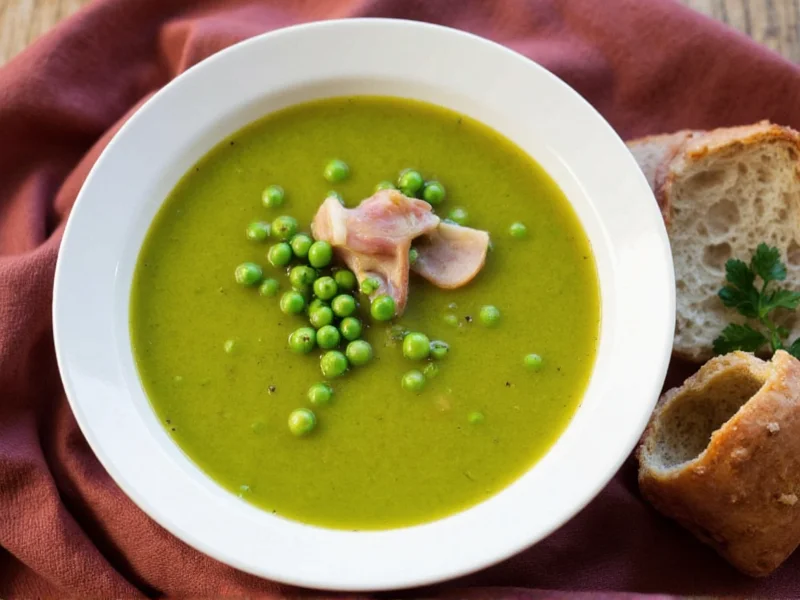Creating authentic pea soup with ham bone requires understanding the synergy between ingredients and technique. Unlike quick versions using canned peas, the traditional method with dried peas and a genuine ham bone produces a richer, more complex flavor profile that's worth the simmering time. The collagen and marrow from the bone enrich the broth, while the peas break down to create that signature velvety consistency.
Why the Ham Bone Makes All the Difference
When preparing pea soup with ham bone, the bone isn't just a flavoring agent—it's the foundation of the entire dish. The smoked ham bone contains connective tissues that melt during cooking, releasing gelatin that naturally thickens the soup. This process creates a luxurious mouthfeel without needing flour or cream. The bone also imparts subtle smokiness that complements the earthy peas perfectly.
For optimal results in your pea soup with ham bone recipe, select a bone with some meat still attached. The residual meat adds additional flavor complexity as it slowly cooks. Avoid pre-cooked ham bones that have been boiled excessively, as they've already released most of their flavor potential.
Essential Ingredients for Authentic Pea Soup
| Ingredient | Why It Matters | Proportion |
|---|---|---|
| Dried green peas | Traditional split peas create the proper texture | 2 cups |
| Smoked ham bone | Provides depth and smokiness | 1 large |
| Yellow onion | Sweet base flavor without overpowering | 1 medium |
| Carrots | Adds natural sweetness and color | 2 medium |
| Celery | Provides aromatic complexity | 2 stalks |
| Bay leaves | Essential herbal note | 2 |
Step-by-Step Preparation Guide
Follow these professional techniques for the best pea soup with ham bone results:
- Prep the peas: Rinse 2 cups dried green peas under cold water, removing any debris. Soaking isn't necessary but can reduce cooking time.
- Prepare vegetables: Finely dice one onion, two carrots, and two celery stalks for even cooking and optimal flavor distribution.
- Start the broth: Place the ham bone in a 6-quart pot with 8 cups of cold water. Bring to a gentle simmer—never a rolling boil—to extract flavor without making the broth cloudy.
- Add ingredients: After 15 minutes of simmering, add peas and vegetables. The gradual temperature change prevents the peas from becoming tough.
- Simmer patiently: Maintain a bare simmer for 1.5-2 hours until peas are completely broken down and soup has thickened. Stir occasionally to prevent sticking.
- Finish properly: Remove the ham bone, shred any remaining meat into the soup, and adjust seasoning. The soup should coat the back of a spoon.
Avoiding Common Pea Soup Mistakes
Many home cooks encounter issues with their pea soup with ham bone due to these preventable errors:
- Boiling instead of simmering: Vigorous boiling makes peas break down too quickly, creating a foamy, uneven texture. Maintain a gentle simmer throughout.
- Adding salt too early: Salt added at the beginning can toughen peas. Wait until the last 30 minutes of cooking for optimal texture.
- Using insufficient liquid: Peas absorb significant water as they cook. Start with more liquid than you think necessary—you can always reduce it later.
- Skipping the resting period: Authentic pea soup with ham bone improves dramatically when allowed to rest overnight, allowing flavors to fully meld.
Variations and Customizations
While traditional pea soup with ham bone follows a specific formula, thoughtful variations can enhance the dish without compromising authenticity:
- Smoked paprika addition: For extra depth without overpowering the ham flavor, add 1 teaspoon smoked paprika during the last 30 minutes of cooking.
- Vegetable enhancements: Leeks or parsnips can complement the classic mirepoix, but add them in the last hour to maintain distinct flavor notes.
- Acid balance: A splash of apple cider vinegar or lemon juice just before serving brightens the rich flavors.
- Texture options: For a smoother soup, blend half the batch before adding the shredded ham back in.
Storage and Reheating Best Practices
Proper storage ensures your pea soup with ham bone maintains quality:
- Cool the soup completely before refrigerating to prevent condensation
- Store in airtight containers for up to 5 days in the refrigerator
- Freeze in portion-sized containers for up to 3 months
- When reheating, add a splash of water or broth as the soup thickens significantly when chilled
- Always bring reheated soup to 165°F (74°C) for food safety
The magic of pea soup with ham bone lies in its transformation over time. The flavors deepen and harmonize remarkably when stored properly, making it an excellent make-ahead dish for meal planning. Many traditional cooks consider day-old pea soup superior to freshly made, as the ingredients have fully integrated.











 浙公网安备
33010002000092号
浙公网安备
33010002000092号 浙B2-20120091-4
浙B2-20120091-4